
find a navigation compass on the bottom corner of every right-hand page. Simply click on the block of Congress about which you’d like to know more, and you’ll automatically jump to that section of the document.



find a navigation compass on the bottom corner of every right-hand page. Simply click on the block of Congress about which you’d like to know more, and you’ll automatically jump to that section of the document.

The Downtown Austin Alliance (DAA) is a partnership of property owners, businesses and individuals whose mission is to preserve and enhance the value and vitality of downtown Austin.
The DAA recently completed a strategic plan that centers around six strategic priorities intended to define how and where the organization will focus its resources to best achieve its mission and vision over the next few years. Congress Avenue was identified as one of the focused priorities because while it functions well today, it could be much more than it is. With a little help, the right stakeholders, a unified vision and well executed ideas Congress Avenue could be Austin’s Champs-Elysees, its Michigan Avenue.
Over the course of the last year, the DAA has had an internal team developing a strategy to help take Congress Avenue to the next level. The team has been made up of DAA Board members, Congress
Avenue property owners, City staff and the Downtown Neighborhood Association. In February 2010, the internal team turned outward and led a workshop to gain insight and input from the community at large. The event, Enhancing the Congress Avenue Experience—Leading Downtown into the Future , was co-sponsored by the Congress for New Urbanism, the Real Estate Council of Austin, the American Institute of Architects Austin chapter, Envision Central Texas, the Downtown Austin Neighborhood Association, Capital Metro, the Heritage Society of Austin and the Austin chapter of the U.S. Green Building Council.
WHAT IS THIS REPORT?
This report outlines the feedback and response received from over 120 participants who represented over 30+ organizations and agencies at the February 2010 workshop. The following pages detail their input and opinions on what Congress should and could become, things that need to change in order to achieve the vision and how they and others can become involved.
As the spine of downtown, the Main Street of Texas, Congress Avenue serves
a ceremonial role not only for Austin but also for the State of Texas. It serves as the potential for the rest of downtown the strength of the spine supports the weight of the whole, and so as Congress goes, the whole downtown goes. So just imagine the place it could become a place that is full of life, is active, vibrant, walkable, the heartbeat of what is authentically Austin and the gateway to the Capital City. The Avenue could be full of interesting places to shop, host to a plethora of outdoor restaurants and sidewalk cafés, a wonderful mix of turn-of-the-century architecture and new more modern buildings, lined with public art and cultural institutions, easy to navigate on foot or by transit, and a great place to people watch. But without a vision and the community, Congress will not live up to its potential.
Turn the pages and rediscover the most famous street in Texas, block by block. Become active in its future and in the future of downtown Austin. It’s time to think of Congress Avenue as that great place that will reside in our hearts and minds forever as one of the great places in the world. There is no better time than now to take that leap from good to exceptional and to lay the foundation for the rest of our downtown.
This Report is not a city plan. It is a set of opinions and recommendations captured in a workshop. It is a vision plan built by the community, for the benefit and betterment of that community.
In February 2010 the DAA hosted an event called “Enhancing the Congress Avenue Experience—Leading Downtown into the Future.” This section is a summary of the charrette event, how it was organized and what charrette participants did prior to and during the event. The report documents the work done by 120 Austin citizens representing more than 30 organizations who came together for one day to envision how to make Congress Avenue, from Lady Bird Lake to the Capitol, a truly exceptional place.
The charrette participants were assigned a specific Congress Avenue block to assess. Prior to the event, participants were asked to spend time on their block and fill out a place evaluation form developed by Project for Public Spaces called the Place Game. Using the Place Game, participants rated their block in terms of comfort and image, access and linkages, uses and activities, and sociability. Participants were asked what they liked best about their block, what they would do to improve the block that wouldn’t cost a lot, and changes they would recommend over the long term. They interviewed folks on the street asking their opinion about the block, and they defined partnerships that could be forged to help implement the vision. This assignment gave participants a chance to look, listen and experience their block with the components of a great public space in mind.
The morning started with an inspiring presentation by Max Reim of Live Work Learn Play, LLP, about great places in the

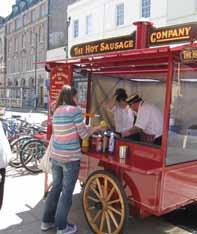


world and what makes a great street. He inspired the participants to think beyond great, that the community has the ability to really make Congress Avenue one of the most exceptional memorable places in the world. It is these exceptional places that inspire us, that are defined by a vibrant street life, a sense of civic pride and superior form. But most of all, exceptional places are defined by the experiences that people share as they interact with the place. Max asserted that Congress Avenue is not living up to its potential, and he

sentence reads, “Welcome to Austin, home of Congress Avenue, known everywhere as ________.”
• You have just spent ‘a day in the life’ along Congress Avenue in 2020.
charged the charrette participants to work together to envision Congress Avenue as one of the greatest places in the world. He sent the participants out to their respective blocks with two assignments. He challenged them to think about what Congress could become by asking them to be tourists in their own community. He asked participants to answer the following questions:
• The year is 2020 and you just picked up a travel guide at the bookstore. You flip to the section about Austin. The first
Describe three most memorable and enjoyable experiences you had in that 24-hour period.
Facilitators guided each team through a block assessment and discussion of what should be done to achieve the experience they envisioned for a transformed Congress Avenue. The discussion included:
• the things they like about their block
• the characteristics and functions of their block
• what they would want to preserve on their block
• the challenges the block faces
• what they want to change on their block
• what things they want to add to their block
• short-term and long-term improvements to get closer to the vision
• what they could personally do starting tomorrow to get closer to the vision
When each team finished their group assessment, they gathered together with all the teams and reported key findings.
Participants shared their block assessment and even though they were assigned different areas of Congress, many of the
from Lady Bird Lake to the Capitol, a truly exceptional place.
groups shared the same goals and vision for Congress Avenue.
The event concluded with a luncheon attended by over 250 people. Those attending were charrette participants and others interested in downtown and Congress Avenue. Max Reim gave a presentation on cities around the world with great streets and provided insight and key outcomes from the morning charrette event. Following his presentation, a panel of local and national experts joined Mr. Reim on stage to answer questions about the future of Congress Avenue. Panelists included Council Member Chris Riley, Jim Adams of McCann Adams Studio, Lee Einsweiler of Code Studio, and Andy Smith of Thomas Properties Group.
Charrette participants consistently identified the following issues as critical components to achieving the vision of Congress Avenue.
Outdoor dining, sidewalk cafés are part of the downtown experience
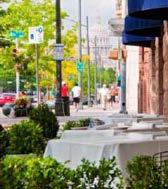
More local businesses, womens and mens apparel, home furnishings, bookstores, and window shopping

Temporary and permanant cultural experiences along Congress Avenue

Charrette participants value the blending of historic and modern architecture


Participants want to ride a streetcar along Congress Avenue

PEDESTRIAN EXPERIENCE
Walking, strolling, sitting, people watching, seeing and being seen


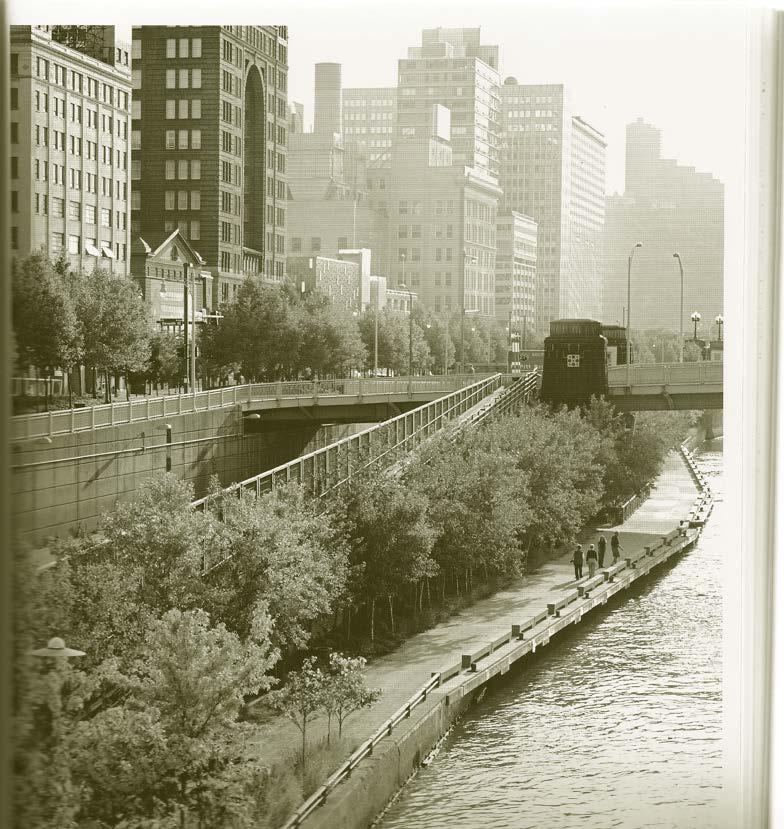

The view from the Ann Richards Bridge facing north is breathtaking. Tree-lined Congress Avenue, the central axis of Edwin Waller’s original plan for Austin, frames the Texas State Capitol. For many, this is the primary gateway and first experience of downtown. It is a place for snapping photos and viewing bats and a logical place to enhance connections between Lady Bird Lake and Congress Avenue.















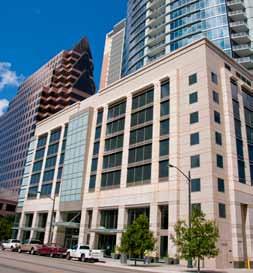
Understated
Congress
The
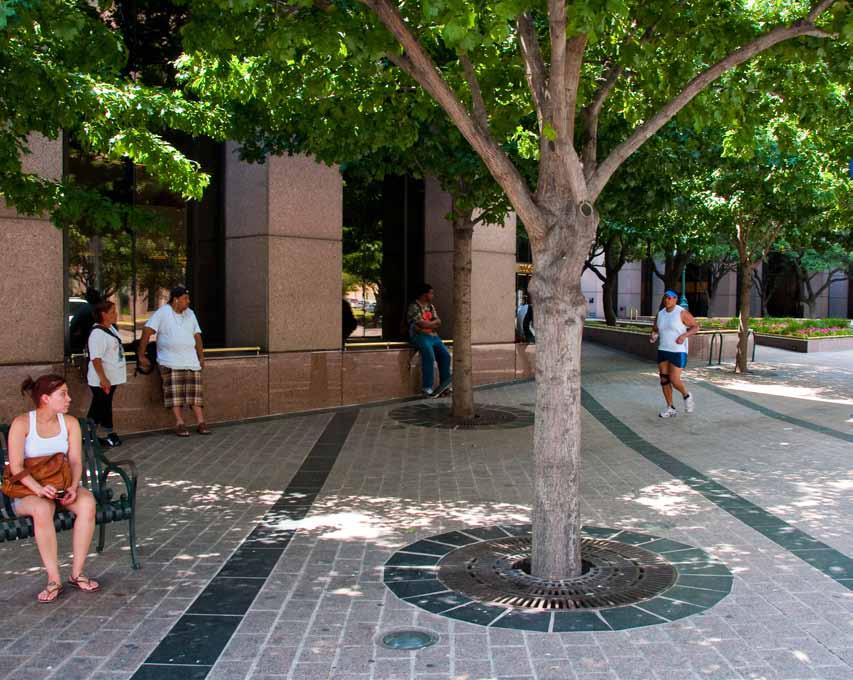
A
Large
Activate the street—add day and nighttime retail and activities
Utilize the potential of the large plazas and the west side of the Radison
Relocate the buses and bus stops
Enhance the landscape along the block

Increase street activity by promoting vendors, busking, entertainment and day and nighttime activity
Public order—promote and manage the cleanliness of public spaces
Eliminate bad behavior to improve public safety
Activate dead spaces and plazas
Increase the number and frequency of pedestrian amenities such as food, music, entertainment, retail and public art
Improve pedestrian crossing safety
Retail that enhances day and nighttime activity
Pedestrian scale uses and vendors
Landscape enhancements—add more color and interest
Invest in public art in the plazas and courtyards
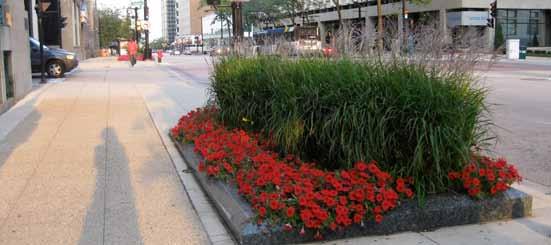
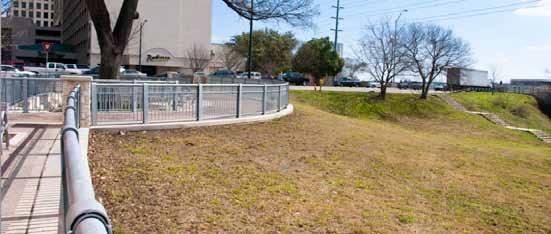

Enhance the connectivity, signage and wayfinding to Lady Bird Lake and the trail
Enhance the Ann Richards bridge as a gateway to downtown and the lake amenities
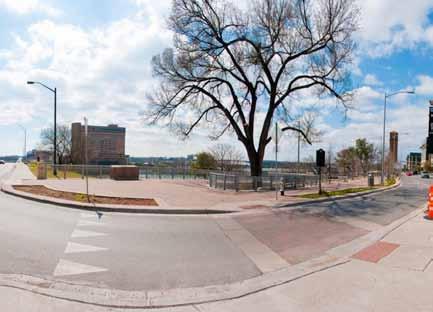
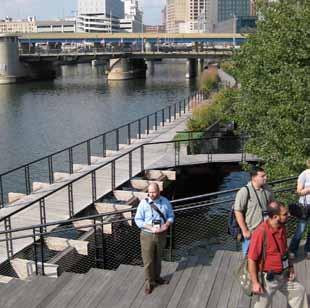
Increase street cleaning frequency
Add signage, maps and banners to promote an enhanced visibility and orientation
Add sidewalk vending and lift permitting restrictions
Enhance the landscaping
Encourage ground-floor retail in existing buildings




The Austonian creates a transition between the specialty shops in the 2nd Street District and Congress Avenue. Described by charrette participants as a “versatile block with great room for change,” the east side of this block offers opportunity to blend historic buildings with new architecture.

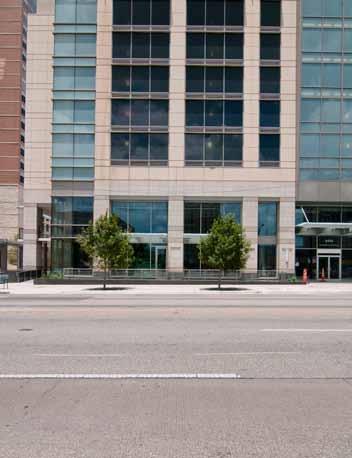


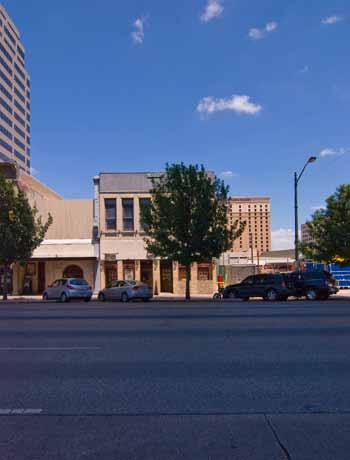
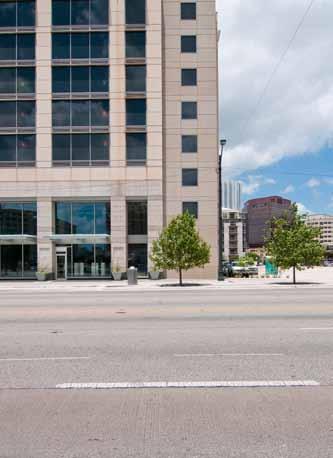








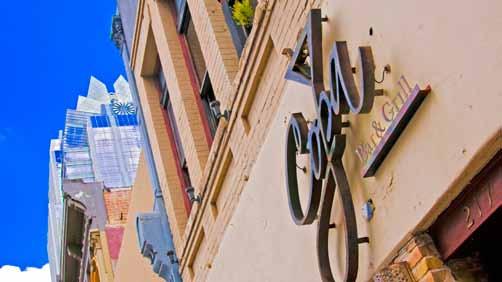


Develop the vacant lots and ensure street level amenities
Get buses off Congress Avenue
Promote wider sidewalks
Improve signage and wayfinding
Provide a balance between cars, bicycles and pedestrians
Amenities and activities that are
Development
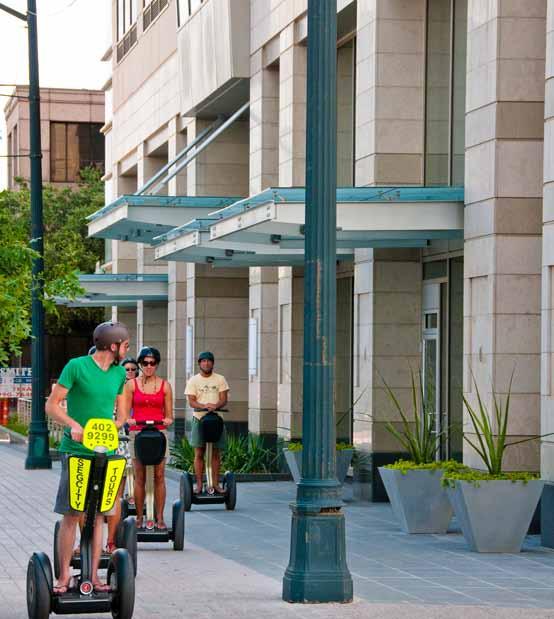
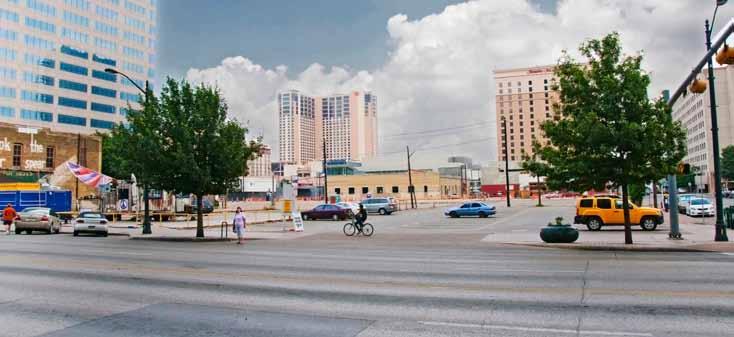
Increase day and nighttime amenities and activities
Encourage new seating and shade
Add landscape that adds color Street vendors
A farmers market in the vacant lots
Develop the vacant lots
Promote pedestrian uses and activities at the street level
Promote compatibility with the street and the historic buildings
Create a complete, built-out avenue
Promote pedestrian balance over cars and parking
Improve signage and wayfinding
Ensure design consistency on the block and along the avenue

Encourage an active participation on the block— frequent the existing retail and restaurants Pick up trash
Promote the block by generating positive word of mouth
Participate in the Downtown Austin Plan



This block offers a great mix of office, food, retail, services and entertainment. Along this small stretch of historic buildings, you can buy a dress or a suit, mail a package, eat lunch at a sidewalk café, visit a jazz club, and drink a margarita.
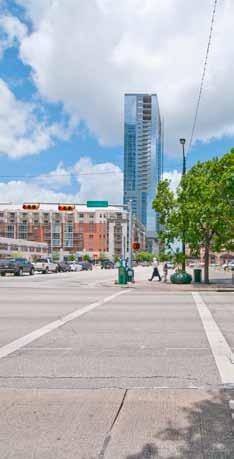



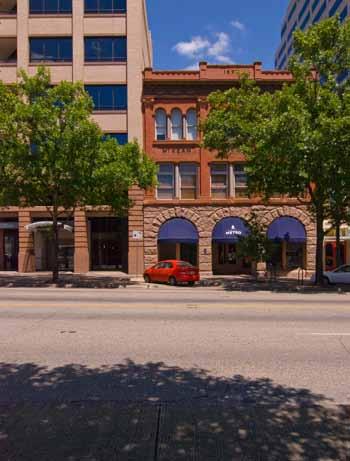
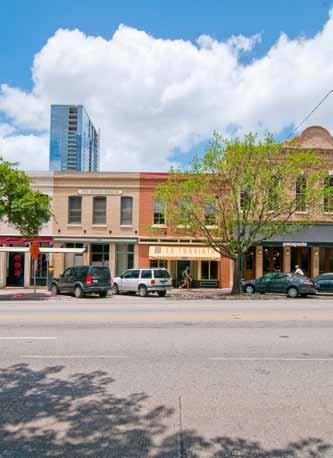





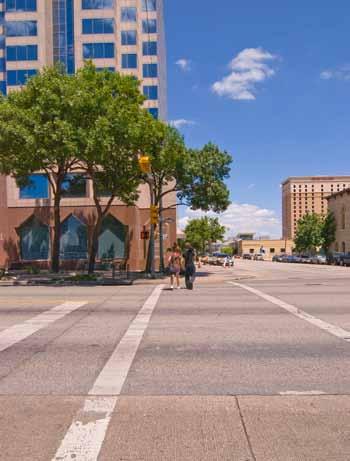
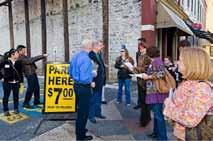




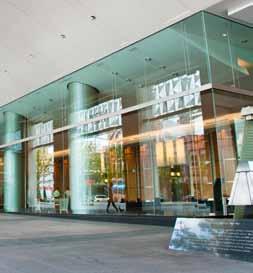


Promote a retail mix that supports outdoor seating, active storefronts, kid-friendly stores
Make codes and policies that encourage retail/restaurant infill
Move Cap Metro office off of Congress
Relocate the bus routes off of Congress
Replace head-in parking with parallel parking
Expand the sidewalks and improve the aesthetics of the street environment by removing unnecessary curb cuts
Remove or replace existing billboards and news racks with a well-designed alternative.
Prune and care for existing trees


Improve the maintenance regime of both the landscape and the sidewalks.
Clean streets and empty trash more often
Add better landscape
Promote a tree-lined avenue, use native plants and encourage owners / retailers to use hanging baskets
Encourage more amenities and activities with the use of banners, outdoor events and more seating
Promote rail on the avenue
Replace head-in parking with parallel parking
Promote great streets
Introduce a consistent, well-designed wayfinding scheme
Redevelop the parking lot
Promote a healthy mix of local and iconic retail
Repurpose vacant and underutilized retail spaces
Encourage sidewalk cafés
Make the avenue a kid-friendly environment
Add
Pedestrian amenities such as seating, lighting, awnings, shade, wayfinding and art
Daily and “spontaneous” events on the avenue
Landscape enhancements by adding native plants, hanging baskets and additional planters
Encourage “guerrilla” parks
Redevelop the vacant parking lot— encourage more residential or a hotel




Clean the sidewalks more frequently
Add well-placed, well-designed furnishings
Promote “guerrilla” landscaping
Encourage sidewalk dining
Event programming
Encourage mobile food vendors
Advocate for rail on the avenue
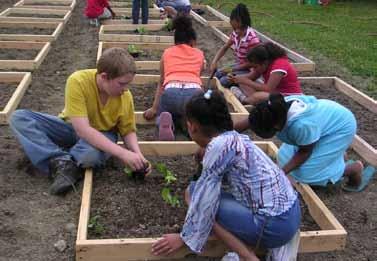


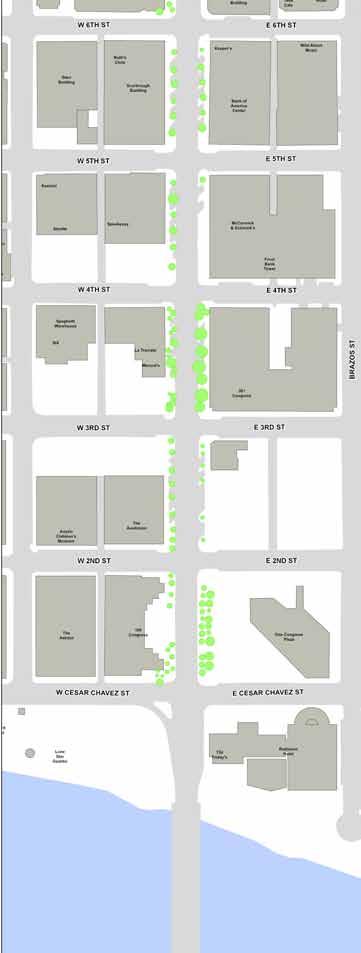
The Frost Bank Tower is a prominent Austin landmark and home to many downtown employees who fill the streets of Congress Avenue during the daytime. The opposite side of the street is dominated by nighttime uses. This block is an important connection between the Convention Center District and Capital Metro’s Red Line commuter rail along Fourth Street. Next door is Mexic-Arte Museum, the official Mexican-American Fine Art Museum of Texas, which serves as a cultural hub of Latino, Mexican and Latin American culture.





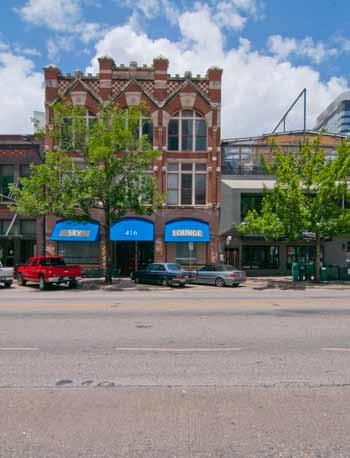



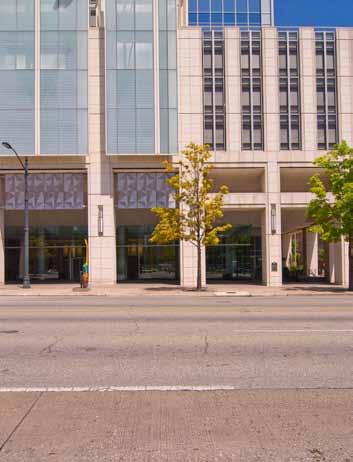

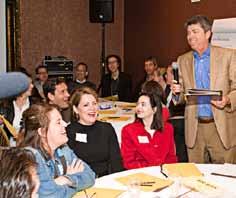




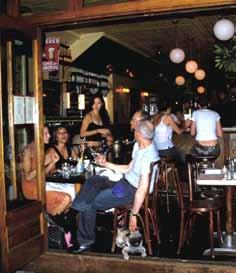




Improve the maintenance regime of both the landscape and the sidewalks
Clean and empty trash more often
Remove the news racks
Add better landscape
Create design and maintenance enhancements, including removing the newsstands, cleaning sidewalks, creating consistent design improvements
Promote “guerrilla” parks
Transform the Frost Bank Plaza to capitalize on an underutilized asset
Encourage more pedestrian enhancements such as outdoor events and more seating
Promote a healthy mix of local and iconic retail
Introduce consistent, well-designed pedestrian amenities
Activate underutilized assets

Create a more diverse mix of retail
Develop surface parking lots
Improve the connection between the retail façades and the sidewalk
Replace the newsstands with a well designed family of furnishings
Retail that promotes a mix of uses
Landscape enhancements to add native plants and year-round color
Larger pedestrian space and add more seating
Retail curb appeal

Small beautification projects, such as planting the existing planters
Remove the news racks
Add landscape planters
Promote “guerrilla” parks
Add banners that promote better wayfinding and branding of the avenue
Encourage more pedestrian enhancements such as outdoor events in the Frost Bank Plaza
Add more sidewalk seating
Initiate improvements to the Mexic-Arte exterior
Incorporate the culture and energy that Mexic-Arte brings to the block
Patronize, participate and promote street life
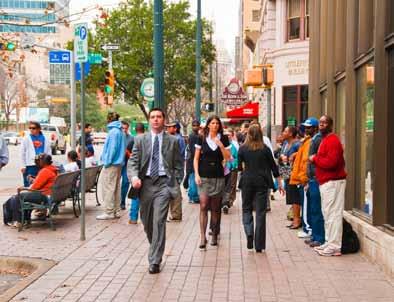

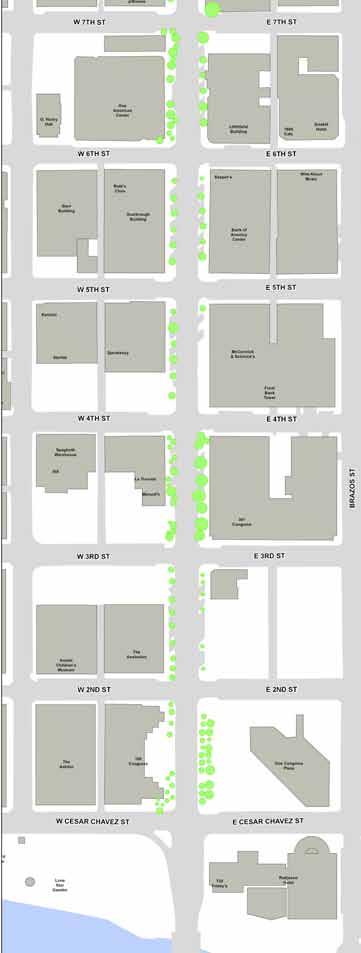
Where Congress meets East Sixth Street is known as “Main and Main.” Austin’s first skyscraper, the Scarbrough Building, was erected here in 1910 in the Chicago School style of architecture. A tribute to old Austin, this block has always served as the commercial center of the city and continues to do so today.


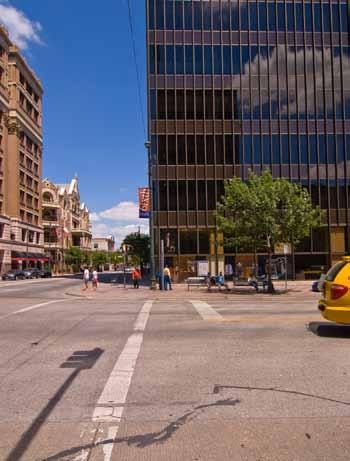
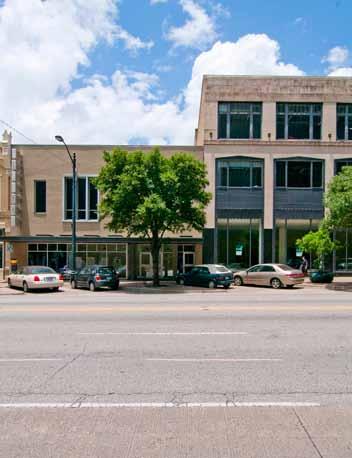














Replace and organize the clutter of the existing newsstands with a welldesigned family of furnishings
Add
and kiosks
Promote a continuous tree-
Remove buses from the avenue
Provide a balance between cars,
Promote social order and manage behavior



Larger
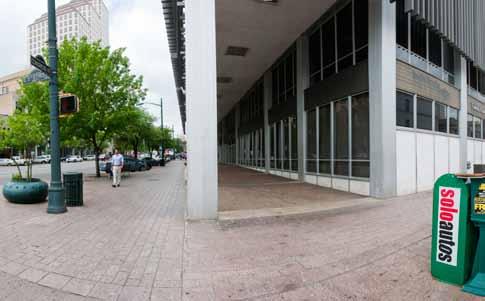
Encourage more pedestrian enhancements such as landscaping, additional benches, plants and trash canse
Improve the maintenance regime of the existing landscape
Promote use of underutilized assets—fill vacant windows and vacant stores with art
Improve the bus stops
Promote a consistent signage and wayfinding scheme
Screen the existing vacant lot.

Add more retail and fully engage it with the sidewalks
Improve the sidewalks and the landscape
Improve the newsstands, the signage and the furnishings
Transform and re-purpose 501 Congress
Develop the vacant lots and ensure streetlevel amenities

Encourage

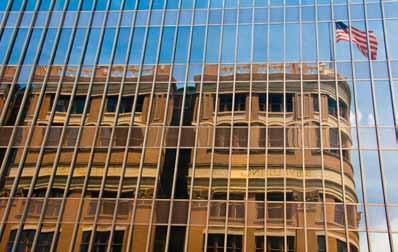
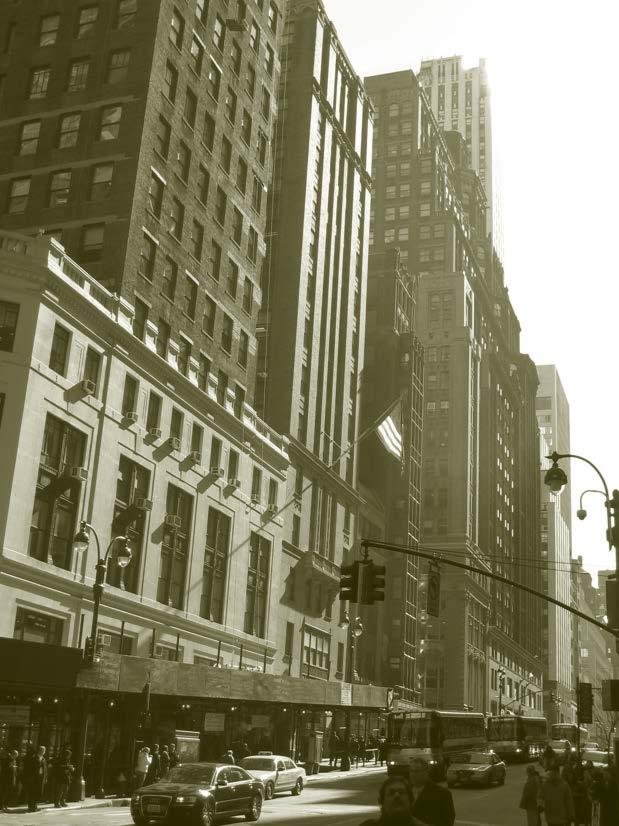

This busy area of Congress Avenue is filled with places to gather. Downtown employees conduct meetings in cafés and courtyards, and visitors rest under the trees or pose for pictures amidst the public art and historic building façades. A bronze statue tells the story of Angelina Eberly, who fired the cannon that helped to keep the state archives, and the state Capitol, in Austin.

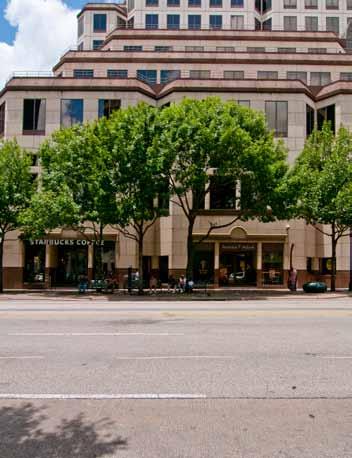


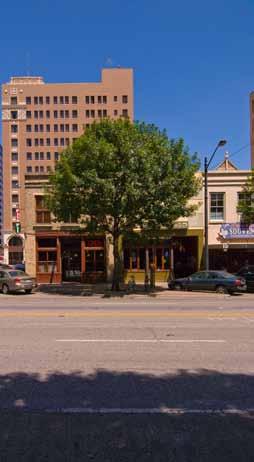
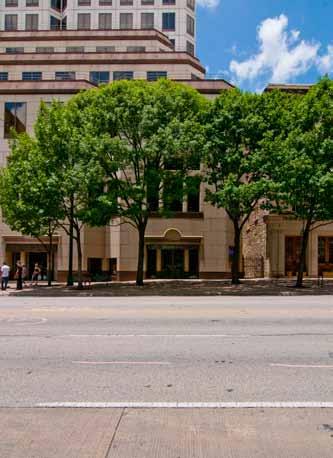





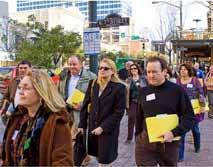


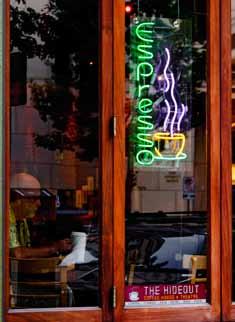



Replace and organize the clutter of the existing sidewalks
Add sidewalk amenities and furnishings
Promote a continuous tree-lined street and encourage additional landscape with native plants
Remove buses from the avenue
Provide a balance between parking and pedestrians
Encourage storefronts to open up and engage the street Add


Improve the maintenance regime of the existing landscape
Promote sidewalk upgrades and repairs and a regular schedule of cleaning
Encourage more landscape, consistent tree wells, native plants and year-round color
Promote hanging baskets on buildings
Encourage more pedestrian enhancements: outdoor events and amenities such as furnishings and litter receptacles
Be creative and fun
Encourage a branded banner campaign for the avenue
Better mix of retail that promotes outdoor dining, sidewalk vendors and better hours of operation
Evening activities and outdoor establishments
Art projects on the avenue
More residential on the avenue



Regularly clean the sidewalks
Add more sidewalk seating
Promote “guerrilla” parks
Encourage sidewalk dining
Encourage more pedestrian programming such as outdoor events and mobile food vendors
Advocate for urban rail on the avenue
Address the challenge of transit, and add rail on the avenue
Promote great streets
Promote sidewalk cafés
Replace head-in parking with parallel
Develop the vacant lot, and ensure streetlevel amenities
Add a better retail mix and fully engage it with the sidewalks
Transform and repurpose vacant space
Improve the signage and wayfinding
Make the block a kid-friendly environment




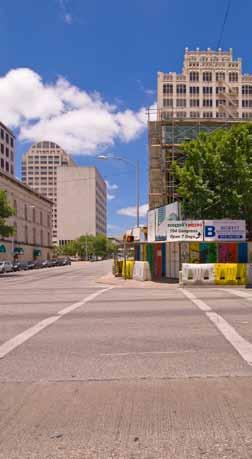
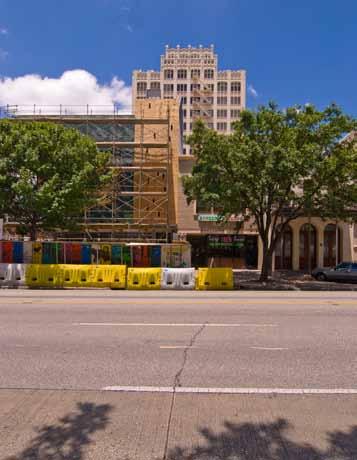





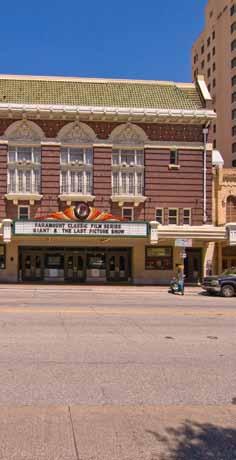
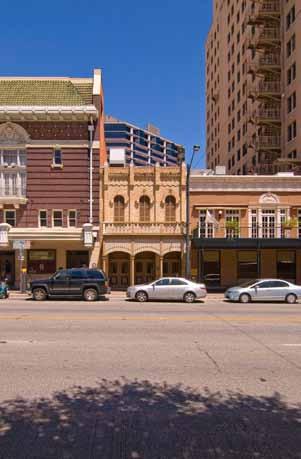


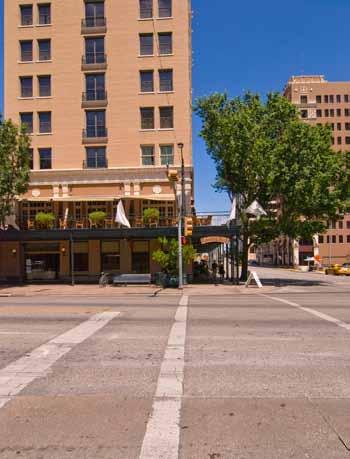

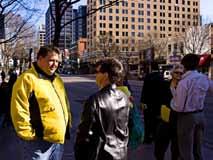


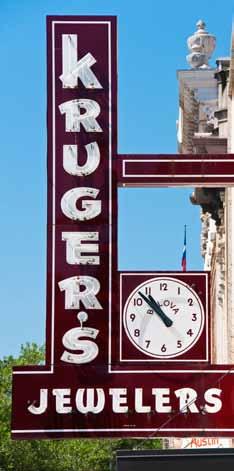


The diversity and mix of materials of the existing historic architecture
The views of the Capitol
The wide sidewalks and the pedestrian amenities
The existing mix of local, well-used retail / uses
The significance of art and cultural establishments


Provide a balance between parking and pedestrians - change head-in parking to parallel
Resolve the issue of “no left turns” and the traffic light sequence
Remove buses from the avenue
Promote great streets with appropriate sidewalk amenities, furnishings and lighting
Encourage a diverse mix of retail and uses
Create an all pedestrian light sequence
Right-of-way management issues need to be streamlined

Better
A streetcar up the avenue
Public-private partnerships that provide facade grants and help the State Theatre
Tools such as a a Tax Increment Finance District (TIF) and an Economic Development Corporation (EDC)


Activate empty spaces and windows with temporary art
Promote sidewalk cafés and outdoor seating
Regularly clean building windows, sidewalks and façades
Encourage more landscape, consistent tree wells, native plants and year-round color
Promote hanging baskets on buildings

Address the challenge of transit, and add rail on the avenue
Replace head-in parking with parallel
Promote the redevelopment of the historic State Theatre
Add a better retail mix, and fully engage it with the sidewalks

Regularly clean and wash the sidewalks and building windows
Promote better landscaping in the existing planters
Create an “all walk” condition for pedestrians at signalized street intersections
Encourage more performance art and music busking
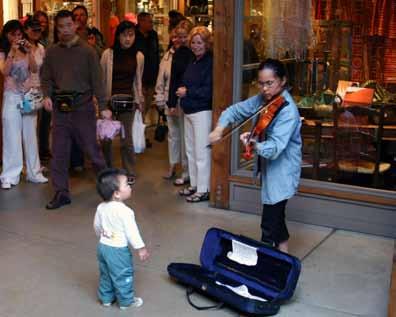



Art and business intermingle with modern and historic architecture on this block, which, with the 700 block, creates a burgeoning cultural hub in the heart of downtown. Major office towers with prominent sculptures and museum headquarters at their base sit next to residences, restaurants and retailers nestled in quaint, well-preserved buildings.
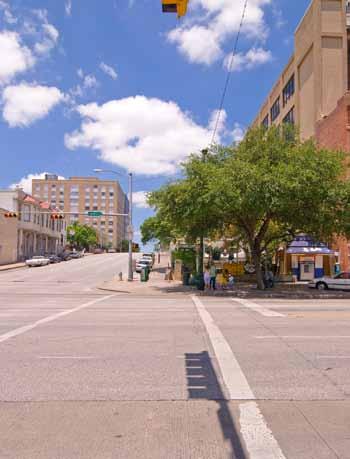





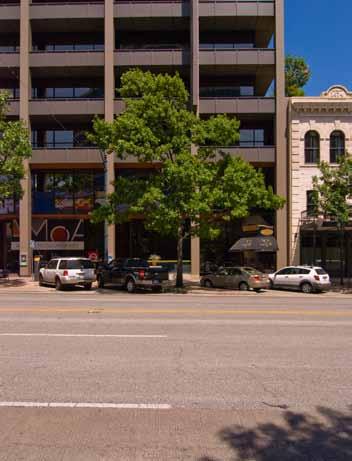





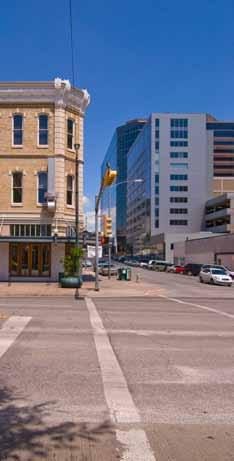

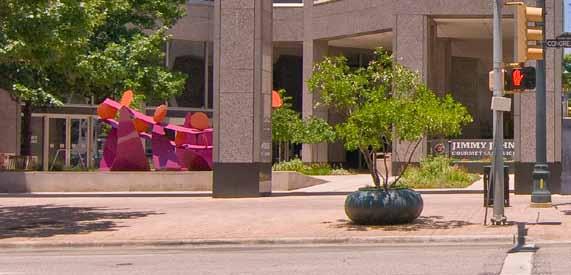


Provide


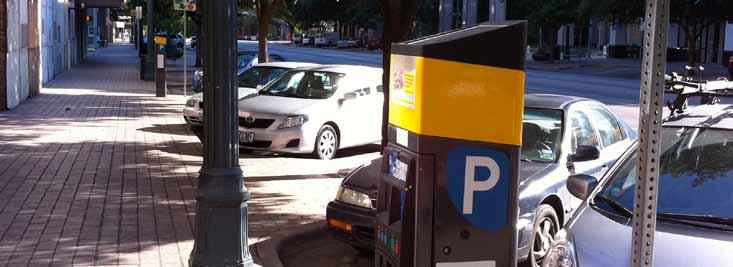
Improve
Provide
Promote
Encourage
Promote
Promote
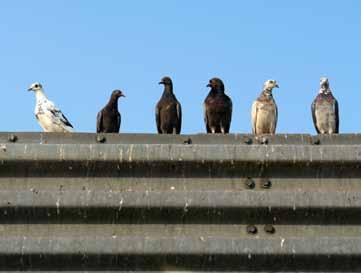

Promote
Remove
Promote
Activate
Improve
Encourage
Promote

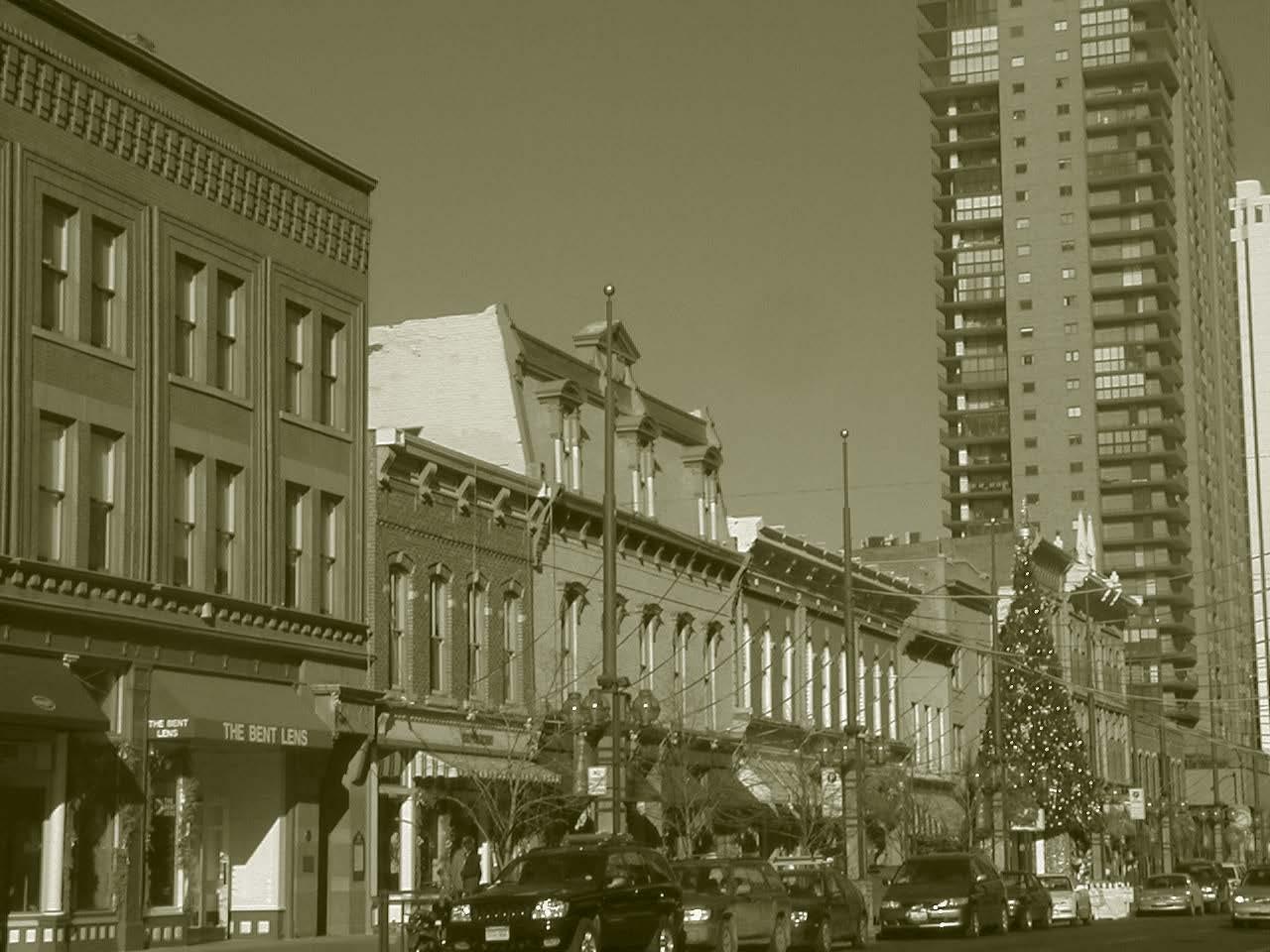
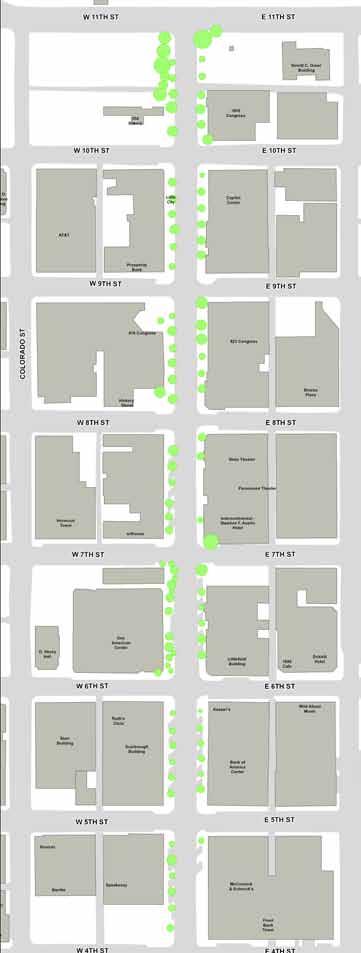
Just a stone’s throw from the Capitol grounds, the shops along this block are among the first encountered by Capitol visitors. This is an active block—filled with local retailers, restaurants, sidewalk dining and a great place for people watching. If rehabilitated, the row of vacant buildings on the east side will add substantial street life to the block.
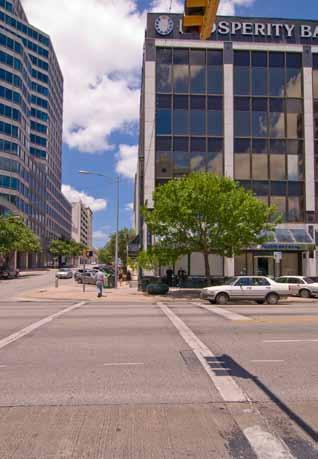

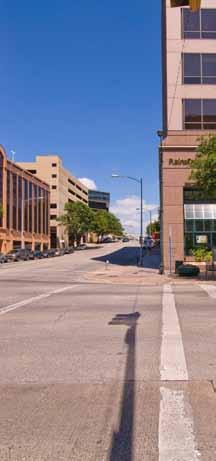
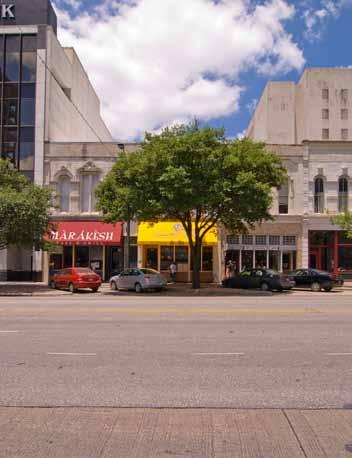

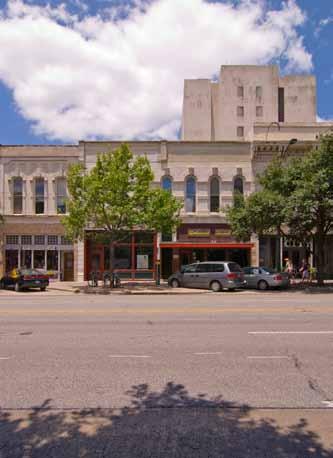
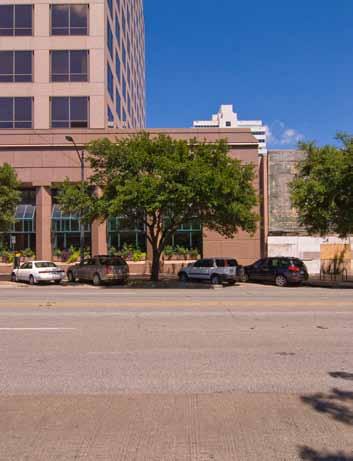





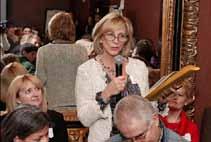


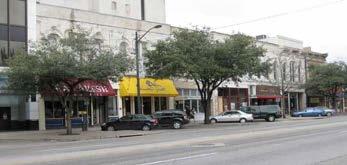



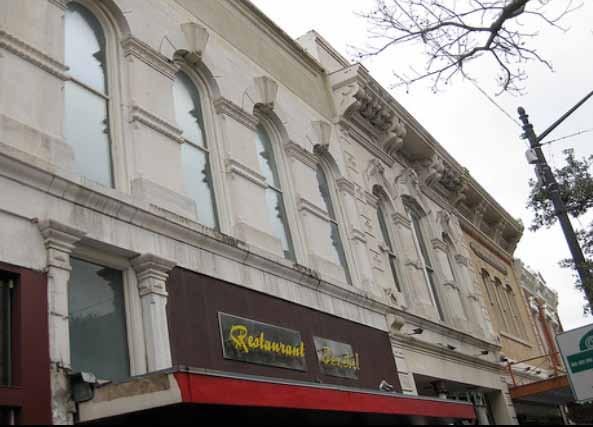
Encourage a diverse mix of retail
Provide a balance between parking and pedestrians—change head-in parking to parallel
Resolve public order issues within the sidewalk and crosswalks
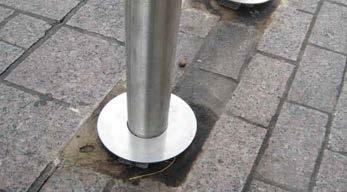
Encourage more landscape, consistent tree wells, native plants and year round color.
Promote hanging baskets on buildings
Promote sidewalk cafés
Encourage additional seating, shade from new tree plantings and pedestrian lighting
Strengthen, diversify and create a retail destination
Address the challenge of transit, and add rail on the avenue
Replace head-in parking with parallel, or have no parking at all and widen sidewalks
Better pedestrian amenities such as seating, more trees, landscape and lighting
Enhance landscaping plantings along the avenue.
Year-round color and interest

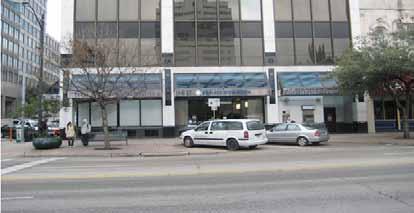
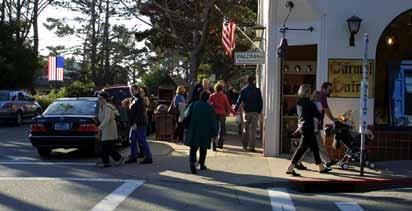
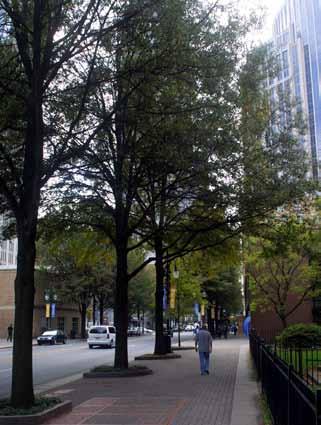
Improve the permit process for license agreements and building permits
Encourage street vendors and a street fair
Promote visual art
Utilize vacant buildings as temporary art exhibits and live music venues

Promote the redevelopment of the vacant buildings, and strengthen the diversity and mix of retail and uses to create a destination
Promote more green space and trees
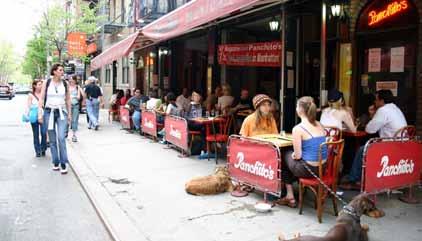


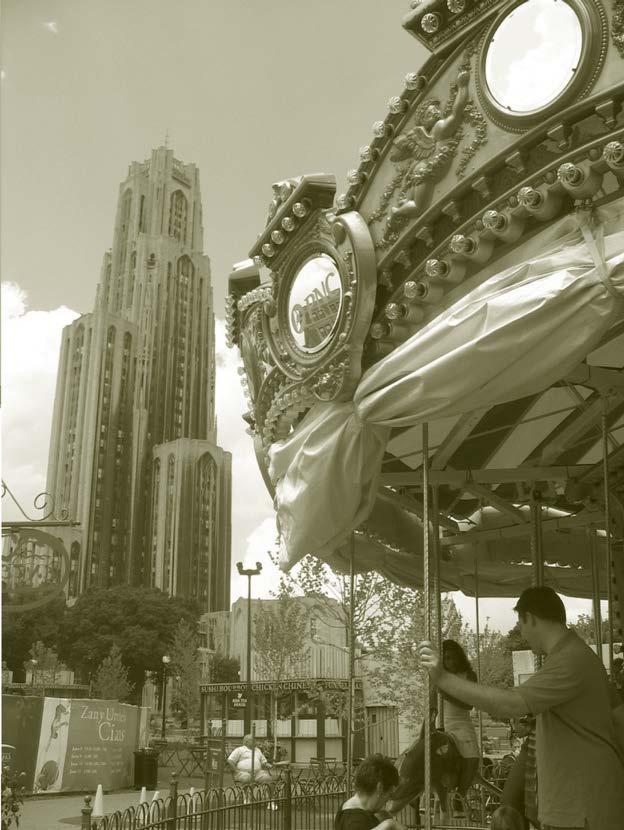



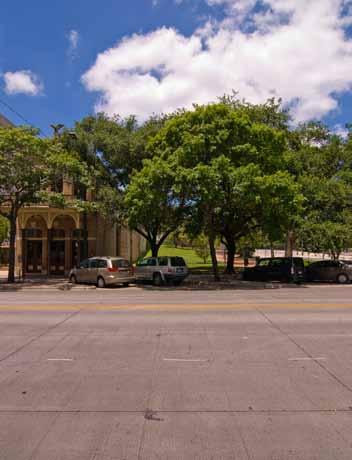
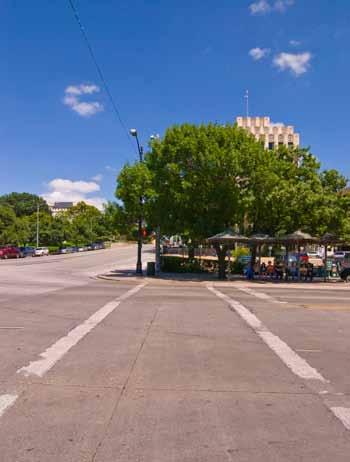





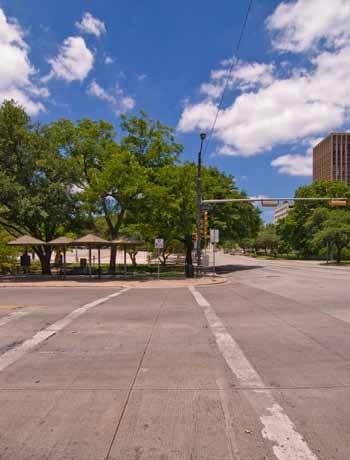
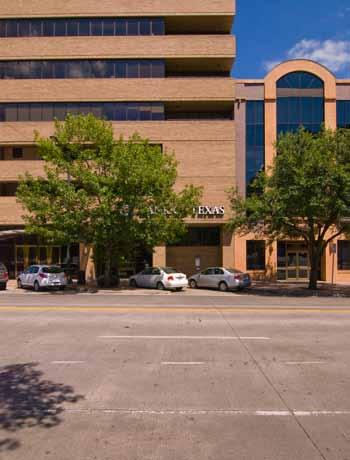

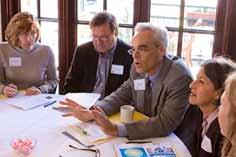
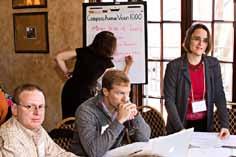
The


The
The
Generous
The block has good redevelopment opportunities
There are multiple government entities and stakeholders
The block needs to fully comply with ADA regulations and be senior friendly
Emphasize the layers of history between state and city themes
Development solutions need to be capable of withstanding heavy use



Transform the existing parking lot
Repurpose the existing public open space
Move the buses off the avenue
Provide a balance between parking and pedestrians - change head-in parking to parallel
Resolve the large blank walls and dark windows of existing buildings


Add
Better pedestrian amenities, such as seating, more trees and lighting
Well-designed sign and wayfinding scheme for the avenue
More landscaping, native plants and year-round color.
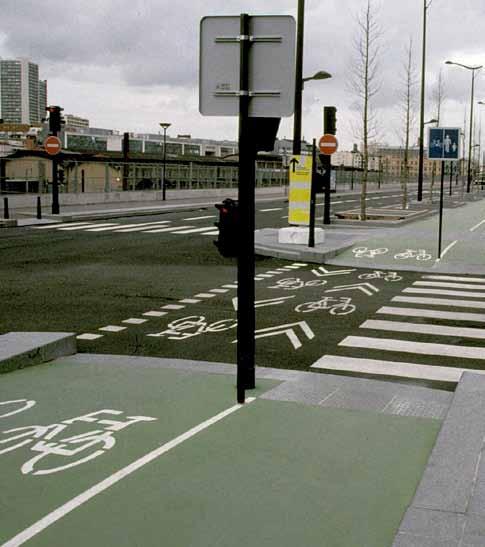
and navigational system
Regularly clean sidewalks, and improve the maintenance regime of the existing landscape
Encourage more landscape, native plants and year-round color.
Promote hanging baskets
Provide additional seating and shade
Improve the existing pocket parks
Enhance the existing bus stop with better furnishings or move altogether
Promote great streets with wider, more generous sidewalks
Replace head-in parking with parallel parking
Add more lighting in existing trees
Promote better pedestrian amenities
Add a better retail mix, and fully engage storefronts with the sidewalks
Promote the redevelopment of the vacant lot/surface parking
Promote the addition of public art
Create a robust redesign of the public spaces to allow for event programming


Have regular meetings with the jurisdictional partners of the city, state and county
Convert the Old Bakery to house tourist information
Empower local property owners to take ownership of the streets around their properties
Promote better landscaping in the existing planters
Reopen the walkway along the west side of the Governors Mansion to reconnect the pedestrian/tourist experience.



Congress Avenue Experiences COMMON THEMES
• Food & Drink (50) – sidewalk cafés
• Experiencing art, culture, theater, shows (46)
• Shopping (37)
• Riding the streetcar, urban rail, trolley (21)
• Walking, strolling, pedestrian experience (17)
• Music (16)
• People watching (13)
• Capitol (12)
• Activity, vitality (10)
• Serendipity (running into friends, meet & greet) (8)
• Appreciating history (8)
• Fun (games, events, parties) (8)
• Kids and families (7)
• Mimes, jugglers, street performers (6)
• Parks/plazas (6)
• Exercise, health, wellness (5)
• Safe and clean (4)
• Quite relaxing (4) specific to bus noise
Congress Avenue Changes COMMON THEMES
• Streetscape/Pedestrian Experience/ Ambience (99)
• Retail Uses/Storefronts (46)
• Transportation (22)
• Art/Music (22)
• Temporary dead space improvements (14)
• Clean and Safe (10)
The following data is from the April 26 presentation. It is an interim assessment of key themes and findings. All of the charrette attendees were asked questions during the event and this represents their responses.
AGENDA
• Charrette Findings
– Congress Avenue Vision
– Congress Avenue Experience
– Congress Avenue Changes
– What I Can Do Tomorrow
– Block Challenges
• Addressing Challenges
• Activating Congress Avenue
• Next Steps
• Questions and Discussion
CHARRETTE REPORTING METHODOLOGIES
• Tabulated All Findings
– Individual PlaceGame
– Visioning Documents
– Charrette Group Reports
• Created a Block-by-Block Assessment
• Identified Common Themes
WHAT WE LEARNED FROM YOU
• You want to be involved
• You have strong opinions
• You want a shared and common vision
• You want action and results
WHAT SITES DO YOU TYPICALLY SEE WITH OUT-OF-TOWN GUESTS?

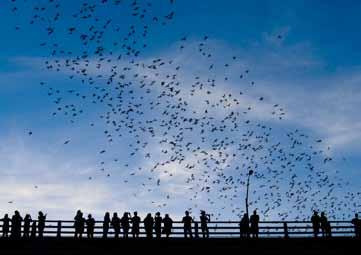
CONGRESS AVENUE VISION–TOP 3 IN RANKED ORDER
The year is 2020, and you just picked up a travel guide at the bookstore. You flip to the section about Austin. The first sentence reads,
“Welcome to Austin, Home of Congress Avenue, known everywhere as…”
1. The Main Street of Texas 2. The Greatest Street in Texas 3. The Avenue of Texas
DESCRIBE THE CHARACTERISTICS YOU WANT TO SEE ON CONGRESS AVE.
Active
HOW MANY TIMES EACH WEEK DO YOU EAT AT A FOOD ESTABLISHMENT ON CONGRESS AVENUE?

THE CONGRESS AVENUE EXPERIENCE
It’s still 2020, and you’ve just spent a day along Congress Avenue.
Describe the three most memorable and enjoyable experiences you had in that 24-hour period.
Sidewalk cafés
More than half focused on outdoor dining and sidewalk cafés
Shopping
Charrette participants want to see more local businesses, bookstore, window shopping
Art, Culture and Theater
Participants want to share more cultural experiences along Congress Avenue
History and Architecture
Charrette participants value the blending of historic and modern architecture
Streetcar/Urban Rail
Participants want to ride a streetcar along Congress Ave.
Pedestrian Experience
Walking, strolling, people watching, see and be seen

WHAT EXHIBIT IS CURRENTLY ON VIEW AT THE AUSTIN MUSEUM OF ART?

CONGRESS AVENUE CHANGES
In order to achieve the memorable experiences you described, list between three and five things about Congress Avenue that would have to change before 2020.
1 Streetscape/Pedestrian Experience and Ambience
• Seating and gathering spaces
• Wider improved sidewalks
• Move buses off Congress
• Outdoor cafés
• Lighting
• Consistent design
• Pedestrian amenities and great streets
• Trees and shade
2 Retail Uses/Storefronts
• More, variety, better mix
• More daytime uses
• More restaurant choices
• Continuous, engaging storefronts
• Better merchandising
• Meld the storefronts with public/private spaces
3 Transportation
• Move (local) buses off of Congress
• Create better transportation options
• Add streetcar/urban rail
4 Art and Music
• More art/sculpture
• Public art
• Live Music/Busking
5 Vacant Space Improvements
• Utilize art/performance to fill in vacant spaces
• Fix boarded-up buildings
• Do something with blank walls
• Utilize food vendors and kiosks
• Utilize plazas
6
•
•
•
•
WHEN WAS THE LAST TIME YOU PURCHASED CLOTHING, SHOES, ACCESSORIES, JEWELRY, ARTWORK OR A GIFT FROM A MERCHANT ON CONGRESS AVENUE?



WHAT I CAN DO
Name one thing that is in your power that you can change tomorrow—no matter how small—that will start the implementation of your vision for your Block and for Congress Avenue.
• Beautify: clean daily, plant plants, pick up trash
• Patronize: participate, promote and buy from Congress retailers and restaurants
• Advocate: participate in the Downtown Austin Plan, promote rail on Congress Avenue, promote the vision for Congress Avenue
WHAT YOU’RE DOING
People are already making changes on Congress Avenue!
Daryl Chalberg
• Planted all 3 planters on the west side of the 600 block of Congress
• Had contractor complete granite sidewalk pavers and grout repairs
• Contacted CapMetro to repair signage at corner of 6th and Congress
• Promoted events on Congress to tenants
David Kruger
• Planted planter ball in front of his store at 722 Congress
The Arthouse
• Painted their temporary covered construction sidewalk in collaboration with their Young Artists @ Arthouse and Club Arthouse
Michele Van Hyfte
• Has been a good patron to businesses: Starbucks, Hideout and other restaurants, retailers
• Serves on the DAA Mobility Committee and advocates for rail on Congress Avenue
Mary Ober
• Has hosted a meeting for the 900 block to begin making progress on their ideas generated at the charrette
Nancy Burns
• Has adopted the planters in the 700 block—purchasing and installing plants, watering daily

AND SIDEWALK WASHING IN THE PID IN A FISCAL YEAR?

CONGRESS AVENUE CHALLENGES
What challenges do we face in achieving our vision for Congress Avenue?
Challenges
• Lack of Shared and Common Vision
• Lack of coordinated efforts among all stakeholders— property owners, tenants, DAA, City, CapMetro, County and State
ADDRESSING THE CHALLENGES
What’s being done to maintain the momentum?
Downtown Austin Alliance
• Maintenance Crew: Getting downtown ready for business every day.
• Downtown Rangers: Helping to make downtown safe; Our eyes and ears on the street
• Professional Staff: Advocate, address and assist
City, County and State
Council Member Chris Riley, City staff, members from the Texas Facilities Commission and the State Preservation Board met to discuss how they can best work together to make Congress Avenue a better place
CITY OF AUSTIN
The City is creating a team to address the issues of Congress as a District. Looking at issues from permitting, right-of-way management, banners, etc. Lead by:
• Sue Edwards, Assistant City Manager
• Howard Lazarus, Acting Assistant City Manager
City of Austin: Coordinated Maintenance
Beginning October 1:
• Public Works will be the sole department responsible for sidewalk maintenance and washing, tree trimming, maintaining medians and planters
• DAA Maintenance Crew will continue to work with Public Works, utilizing new equipment including a gum removal machine
City of Austin: The Old Bakery
• Reconfiguring and updating store
• Adding visitor information
• Visioning the future role of the Old Bakery and Pocket Park
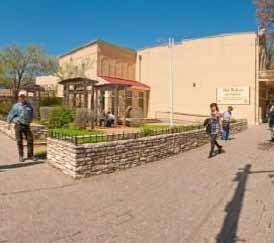
CAPITAL METRO
• Problem Solver/Solutions Coordinator
• Plan with timeline and with deadlines will be created for moving the buses off of Congress Ave. to Guadalupe and Lavaca, as adopted by ServicePlan 2020
ACTIVATING CONGRESS
What’s being done to make Congress Avenue a more lively destination?
One Congress Plaza
• Working to program plaza for noontime concerts in spring and fall

721 Congress
• Pop-Up Art Installation in conjunction with Art Week Austin
Retailer Evie Evan at 504 Congress
• Cosmetics company’s national headquarters with retail storefront
Retailer Austin Details at 801 Congress
• Art Gallery with artist services
823 Congress: Austin Museum of Art
• AMOA envisions transforming it’s sidewalk and entrance
501 Congress Plaza
• Property owner is rethinking the streets, plazas and empty spaces, and envisions transforming the space
SINCE THE DAA BEGAN ACTIVELY RECRUITING RETAIL IN 2005, HOW MANY NEW RETAILERS HAVE OPENED ON CONGRESS AVENUE?

WHERE DO WE GO FROM HERE? How can we keep the momentum?
Next Steps
• Final Report
• DAA Board/Strategic Committee
• How-To Toolkit
• Communications
Join the “Congress Avenue” Facebook Group
• Share photos, successes, ideas, updates, meeting locations, info
Get Started TODAY!
• Join a DAA Committee:
– Arts & Entertainment
– Security & Maintenance
– Parks
• Adopt a Planter:
– May-Oct. 2010
– How-To Guide
– Sign up and create partnerships
• Take an Active Role














!"#$"%&'%()*$+)%$* "#$!%&'(')!)*+''*! ,&)*-%.!*'/,)!010#234420! 56789!:;24<!=003"">>! ?@A!:;24<!=0>34204! B6CCD.!

R6PH!(O!S6JL6H!---!















Data tabulated from participants Placegame form, group discussion and Vision document
Can do tomorrow:
• Clean daily
100 BLOCK- SUMMARY
What do you like best about this block?
• Connectivity/Proximity to the Lake and Views of the Capitol (7)
• Sidewalks – landscaping, trees, fountain (5)
Block characteristics/function:
• Large spaces – plazas, wide sidewalks, mature trees (4)
• Location – proximity to the Lake/Trail, and to 2nd Street (2)
• Transportation – transit corridor, no on-street parking (2)
Block challenge:
• Transit – traffic, pedestrian crossings, Congress bridge, disconnects (6)
• Attractiveness & Lack of Activity – empty plazas, opportunity with retail (5)
• Perceptions related to safety (2)
Preserve:
• Historic buildings (2)
• Trees (1)
• Wide sidewalks (1)
Change:
• Add life – to plazas, activities, retail, Westside of Raddison, plants (5)
• Move buses (1)
Add:
• Retail – pedestrian scale use, vendors (3)
• Landscape – add color, plants, terrace, art (2)
Short-term improvements:
• Street Activity – vendors, busking, entertainment/ activity (6)
• Public Order – clean, manage and eliminate bad behavior (4)
• Connectivity & Signage – wayfinding, connection to lake/trail (3)
Long-term improvements:
• Activate – plazas, dead spaces, eliminate parking lots, redevelop motor bank (8)
• Amenities – food, music, entertainment, pedestrian crossings, retail art (6)
• Attractive – make a gateway with bridge, clean it up, make it safe, tie to lake/trail (5)
• Signs/maps/banners
• Sidewalk vending (vendors/permitting issues)
• Improve landscaping
• Add retail
200 BLOCK- SUMMARY
What do you like best about this block?
• Potential – opportunities especially with the Austonian (4)
• Activity/Connection/Mix – daytime activity, connection to the lake, mix of businesses (4)
• Historic Buildings (2)
• Sidewalks – pedestrian amenities (2)
Block characteristics/function:
• Potential – connection/density/redevelopment (6)
• Historic buildings (3)
• Streetscape – seating, great streets (3)
• Residential (2)
Block challenge:
• Finance/economy/competition (6)
• Shared Vision – policies, regulatory environment (3)
Preserve:
• Historic buildings and mural (7)
• Sidewalk amenities – trees, lighting, width (3)
Change:
• Vacant lots – level, redevelop (5)
• Transit – buses off Congress, balance street & pedestrian, street grade (3)
• Sidewalk/Amenities – wider sidewalks, signage (2)
Add:
• Pedestrian use/scale/amenities/activities (7)
• Redevelopment/Development that fits/adds density and amenities (4)
• Retail/mixed use/street vendors (3)
Short-term improvements:
• Amenities – shade, seating, plants, color (5)
• Activities – vendors, farmers market (4)
Long-term improvements:
• Redevelopment of parking lots with pedestrian use, compatibility to street and to historic buildings (10)
• Create a true Avenue – pedestrian balance, street level activities, wayfinding, design consistency, transit (6)
Can do tomorrow:
• Actively participate in space – eat, shop, pick up trash (6)
• Promote/sell the block; spread the word (3)
• Participate in the downtown plan (2)
What do you like best about this block?
• Architecture – historic/modern/adaptive re-use (9)
• Mix of uses – retail, sidewalk cafés (5)
• Location/views of the Capitol/pedestrian scale (4)
• Trees (4)
Block characteristics/function:
• Place to see & be seen (3)
• Retail mix (7)
• Architecture – mix of old and new (3)
Block challenge:
• Creating a unified vision with all parties (7)
• Redevelopment of parking lot/repurposing of Frost Plaza (6)
• Guiding the free market/affordability (3)
Preserve:
• Retail – mix, local, iconic businesses (7)
• Historic façades (6)
• Scale of street (2)
Change:
• Retail Mix – outdoor seating, storefronts, kid friendly, make codes/policies easier (7)
• Transit – relocate buses, move CapMetro office, remove angle parking and expand sidewalks (6)
• Aesthetics – eliminate curb cut, remove billboard, newsracks and prune trees (6)
Add:
• Amenities/Activities – seating, lighting, awnings, shade, wayfinding, art, events (10)
• Landscaping – attractive plants, hanging baskets, guerilla park, planters (5)
• Use/Redevelopment of parking lot – residential, hotel (3)
Short-term improvements:
• Sidewalk improvement/general maintenance/ clean (9)
• Landscaping – tree wells, plants, hanging baskets (5)
• Amenities/Color/Activities – banners, events, outdoor seating, creative and fun (5)
Long-term improvements:
• Transit – rail, great streets, replace angled with parallel parking, wayfinding (5)
• Redevelopment of surface parking lot (4)
• Retail mix – repurpose space, create sidewalk cafés, kid-friendly environment (4)
Can do tomorrow:
• Clean-Up/Landscaping – clean sidewalks, add seating, guerilla landscaping (8)
• Activity/Retail – sidewalk dining, event programming, mobile food carts (5)
• Advocate for Rail (2)
400 BLOCK- SUMMARY
What do you like best about this block?
• Historic buildings (4)
• Views of Capitol and river (5)
• Frost Tower (2)
• Wide sidewalks (2)
Block characteristics/function:
• Mix of architecture and uses - small retail, museum, services)(9)
• Premier office building, density (6)
• Central node of activity (4)
Block challenge:
• Bars and night-oriented uses dominate - no day use, limited activity (9)
Preserve:
• Historic buildings (4)
• Views (3)
• Shade (2)
Change:
• Retail uses (mix) (4)
• Surface parking (3)
• Connection between façades and pedestrian realm (3)
• News racks (2)
Add:
• Retail mix (4)
• Plants and color (3)
• Pedestrian space/seating (2)
• Retail curb appeal (2)
Short-term improvements:
• Design and maintenance enhancements -remove newsracks, guerilla parks, clean sidewalks, consistent tree grates, etc. (8)
• Plants and color (4)
• Activate spaces (2) (Frost Plaza)
• Pedestrian enhancements/seating (2)
Long-term improvements:
• Retail mix (5)
• Design/maintenance enhancements (5)
Can do tomorrow:
• Small beautification projects -guerilla parks, removal of newsracks, planters, banners (10)
• Activate spaces - seating & programmed events at Frost, improvements to Mexic-Arte exterior (7)
• Patronize, participate, promote the existing street life (5)
What do you like best about this block?
• Great location, lots of potential (7)
• Historic architecture, views of the Capitol (4)
• Sidewalks – wide, trees, clean, shade (4)
Block characteristics/function:
• Architecture – historic, old meets new (9)
• Central/Great location – Main & Main (5)
• Sidewalks and Amenities – wide sidewalks, awnings (4)
Block challenge:
• Lack of common vision/coordinated efforts/ management/money (10)
• Vacancies – lack of retail, activity and potential (5)
• Transit – bus routes; number of buses (2)
Preserve:
• Historic buildings/heritage/views of the Capitol (8)
• Retail – culture of retail (4)
Change:
• Design & maintenance needs – organize clutter (newspaper racks), sidewalk amenities, trees, kiosks, (10)
• Transit – remove buses, create balance with transit, pedestrian and bikes (10)
• Social order – manage behavior (4)
Add:
• Transit – trolley/street car, bike parking, electric plug-in stations (7)
• Amenities/Activities – public restrooms, activities, kiosks, reasons for street activity (7)
• Sidewalks – redesign, trees, lighting, seating (6)
• Retail – more retail, sidewalk cafés (4)
Short-term improvements:
• Sidewalk Amenities/Landscaping – plant, maintain, rearrange, add benches, plants, trash cans (6)
• Utilize under utilized spaces – windows, vacant areas with vendors, art, etc. (5)
• Improve transit/vacant parking lots – bus stops, signage, screen vacant lot (3)
Long-term improvements:
• Retail – add more retail, bring retail to the sidewalk (5)
• Sidewalks/Landscaping – improve sidewalks, landscaping, newsstands, signage, benches (5)
• Redevelop/repurpose – 501, vacant parking lot, better activities (4)
Can do tomorrow:
• Street vendors (4)
• Special events (4)
• Activating dead spaces (3)
What do you like best about this block?
• Ambiance – look, feel and location (5)
• Art (3)
• Retail mix and buzz (2)
Block characteristics/function:
• Sidewalk/ Public Realm – benches, trees, clock, awnings, sidewalk café, courtyard (7)
• Retail mix and use (7)
• Art and theater (2)
Block challenge:
• Common Vision and Support – money, policy, attitudes (4)
• Public Amenities/Safety – public restrooms (2)
• Retail – mix of uses and affordability (2)
Preserve:
• Sidewalk/Public Realm – trees, wide sidewalks, granite pavers, clock (6)
• Architecture – diversity, density and materials (3)
• Retail – local businesses and mix of good uses (2)
Change:
• Sidewalk – obstacles, clutter, seating, furniture, trees, plants (6)
• Transportation – bus stops, parking and pedestrian balance (5)
• Open up storefronts to the street (One American Center) (2)
Add:
• Retail – better mix, outdoor dining, sidewalk vendors, better hours, marketing (10)
• Activity & Art - art projects, evening activities, outdoor establishments (3)
• Residential (2)
Short-term improvements:
• Sidewalk – add seating, plantings, trim trees, placemaking (4)
• Clutter/Clean – clean façades, remove clutter, deal with panhandling & solicitors (4)
• Retail – better storefront access, clean signage, sidewalk cafés (3)
Long-term improvements:
• Transit – rail, comprehensive parking, improve taxi stand, widen sidewalks, less parking (5)
• Retail – better mix, information for tourists, signage (4)
• Façade Improvements – open storefronts to street (2)
Can do tomorrow:
• Street performers (2)
• Create fund to repair sidewalk and improve (2)
• Fill planters (2)
What do you like best about this block?
• Historic buildings and signage (7)
• Sidewalks, trees, etc. (6)
• Scale and architecture (5)
• Mix of uses (3)
Block characteristics/function:
• Historic architecture, views of the Capitol, scale (8)
• Mix of uses/retail (2)
• Art (2)
Block challenge:
• Lack of political will and vision (8)
• Retail use and mix (4)
• Affordability (2)
Preserve:
• Architecture, historic buildings, views of the Capitol, scale (5)
• Retail/use (4)
• Sidewalk and pedestrian amenities (4)
• Art and cultural uses (3)
Change:
• Transportation – parking, no left turns, light sequence, remove buses (8)
• Great Streets – amenities, lights in trees, ROW management, furniture (5)
• Retail mix (2)
Add:
• Streetscape/Pedestrian amenities (4)
• Transportation – streetcar (4)
• Public/Private Partnerships – façade grants, State Theatre, TIF, EDC (3)
Short-term improvements:
• Activate empty spaces/windows with temporary art (4)
• Sidewalk cafés and seating (3)
• Clean – windows, sidewalk, façades (3)
• Add plants, flowers (2)
Long-term improvements:
• Retail – add retail/change the mix/activate first floor use (7)
• Redevelopment opportunities – 721, State Theatre (5)
• Transportation – parking, streetcar (4)
Can do tomorrow:
• Beautify – wash windows, landscaping, clean, decorate (6)
• Light cycle for pedestrians – create an all walk sequence (2)
• Performances for art/music buskers (1)
800 BLOCK- SUMMARY
What do you like best about this block?
• Architecture, historic buildings, views of the Capitol (10)
• Art/sculpture (5)
• Wide sidewalks and trees (3)
Block characteristics/function:
• Historic, architecture, views of the Capitol (6)
• Plaza and pocket parks (3)
• Art and music (3)
• Street vitality (2)
Block challenge:
• Lack of community buy-in/vision (3)
• Infrastructure – electrical, wider sidewalks, reconfigure parking (3)
Preserve:
• Retail mix (5)
• Historic buildings, architecture, views of the Capitol (3)
• Art (4)
Change:
• Improve 1st floor retail uses – activate dead spaces, open stores at night, more retail (7)
• Sidewalk infrastructure- parallel parking, larger trees, remove ATMs, street lights (7)
Add:
• Sidewalk infrastructure –gathering spaces, larger sidewalks, seating, more trees, lighting (6)
• Retail Activity – vendors, more retail, daily events (3)
Short-term improvements:
• Sidewalk amenities/infrastructure/clean – trees, bird control, planters, seating, shade (11)
• Retail – improve mix, street vendors, storefront improvement, sidewalk cafés (5)
• Activity and partnerships – events, partnermuseum & restaurant (4)
Long-term improvements:
• Retail mix – enhance and strengthen (7)
• Transportation – street car, parallel parking (5)
• Art – more sculpture, add public art on the sidewalk (4)
• Streetscape – amenities and design – update, give it consistency (4)
Can do tomorrow:
• Clean & spruce up – plant plants, remove unsightly signage, remove newspaper racks (6)
• Sidewalk – more street furniture, improve permit process (4)
• Activity – hold concerts, business and art partnerships, activate dead spaces (3)
What do you like best about this block?
• Historic fabric, views of the Capitol (12)
• Retail mix and activity – local flavor (8)
• The potential exists (3)
Block characteristics/function:
• Historic – views of the Capitol, architectural styles (7)
• Unique retail and retail bones – façades, awnings, windows (7)
• Redevelopment opportunity – 907, 909 and 911 (2)
Block challenge:
• Transportation – take buses off, streetcar, remove/modify parking (6)
• Disparate ownership/ lack of shared vision (4)
• Coordinated effort/management of vision (4)
• Vacant buildings (2)
Preserve:
• Historic buildings/scale/character (4)
• Great Streets/Street amenities – wider sidewalks, trees, granite material (4)
• Relationship to other blocks (2)
• Retail (2)
Change:
• Vacant buildings (3)
• First floor uses/design (3)
• Parking – parallel (2)
• Public order issues (2)
Add:
• Sidewalk/pedestrian amenities – wider sidewalks, lights in trees, art, seating (6)
• Plants/color (2)
Short-term improvements:
• Landscaping – plants, flowers, baskets gardens (7)
• Sidewalk realm – outdoor cafés, shade, permit modifications, chairs, lights in trees (6)
• Retail – street vendors, restaurants, street fair (5)
• Art – visual art, temporary art on abandoned buildings, live music (3)
Long-term improvements:
• Retail – strengthen, diversify, create a destination (8)
• Great Streets/Transit – wider sidewalks, parallel/ no parking, rail more green, more trees (7)
• Redevelopment opportunities – boarded up buildings (3)
Can do tomorrow:
• Create activity – events, tours, jogging (3)
• Clean-up vacant façades (2)
• Advocate – rail; incentives (2)
What do you like best about this block?
• Historic Buildings/Views of the Capitol (8)
• Greenspace – pocket parks, Capitol grounds (4)
• Activity tied to seasons (1)
Block characteristics/function:
• Point of entry – front porch to the Capitol/ Congress (6)
• Visitors, sightseeing, information point, civic center (5)
• Open space/pocket parks – programmable and engaging spaces (3)
• Redevelopment opportunities (1)
Block challenge:
• Transportation – making it effective, heavy use (2)
• Multiple governmental entities and stakeholders (2)
• Making it senior friendly, emphasizing history –state and city themes (1)
Preserve:
• Views to the Capitol
• Historic Buildings
• Parks – pocket parks and open space
Change:
• Parking lot/open space (4)
• Transit – move buses, parallel parking, great streets (4)
• Blank walls and dark windows (2)
Add:
• More places to sit/rest (3)
• Signage and wayfinding (3)
• Plants and color (2)
Short-term improvements:
• Landscaping – plant colorful plants, hanging baskets (5)
• Improve pocket parks – plantings, clean, seating, programming (4)
• Enhance/move bus stop – clean, more seating (3)
Long-term improvements:
• Great Streets – wider sidewalks, parallel parking, lights in trees, pedestrian amenities (5)
• Storefront/retail engagement (5)
• Public space – program, redesign, add art (5)
• Redevelopment of NE corner (4)
Can do tomorrow:
• Meet with jurisdictional partners – city, state, county
• Put tourist information at the Old Bakery
• Talk with business owners about taking ownership of their space
• Plant planters
The following individuals participated in the February 2010 charrette. Each team was led by a volunteer facilitator and a volunteer note taker.
100 BLOCK
Katherine Nicely, Facilitator
Julie Fitch, Note Taker
Jeb Boyt
Barksdale English
Jerry Harris
Lori Kline
Michael Knox
Richard MacKinnon
Susan Rankin
Tom Schurr
Charles Vaclavik
200 BLOCK
Daniel Woodroffe, Facilitator
Marisa Ballas, Note Taker
Linda Atkins
Kevin Burns
Lee Einsweiler
Fred Evans
Tim Finley
Glenn Gadbois
David Juarez
Eleanor McKinney
Amanda Taylor
Aaron Vollmer
300 Block
Facilitator – Roger Cauvin
Note Taker – Bill Brice
Boone Blocker
Janis Daemmrich
Mary Davidson
Gordon Derr
Charlie Fulton
Marshall Jones
Jana McCann
Stephanie McDonald
Alex Pope
Amanda Swor
400 BLOCK
Greg Anderson, Facilitator
Larry Schooler, Note Taker
Megan Crigger
Katherine Gregor
Ann Jacobson
Howard Lazarus
Andrew Moore
Judy Moss
John Rosato
Sania Shifferd
Andy Smith
500 BLOCK
Ryan Keathley, Facilitator
Linda Asaf, Note Taker
Glenn Coleman
Sue Edwards
Robert Hinojosa
John Horton
Michelle Perez
Mike Reynolds
Tom Stacy
Jessica Thompson
Michele Van Hyfte
600 BLOCK
Effie Brunson, Facilitator
Thomas Butler, Note Taker
David Bodenman
Daryl Chalberg
Jennifer Gardner
Greg Kiloh
Jerry Rusthoven
Bill Koen
Florence Mayne
Rebecca Melancon
Jim Nix
Anne Wheat
700 BLOCK
David Knoll, Facilitator
Josh Allen, Note Taker
Sinclair Black
Nancy Burns
Dale Glover
Caleb Gutshall
Sharon Kilmartin
David Kruger
Lori Martin
Bratten Thomason
Jennifer Wijangco
800 BLOCK
Diane Miller, Facilitator
Charlie Betts, Note Taker
Gwen Blaise Johansen
Cristina Bordin
Jim Collins
Dana Friis-Hansen
Jamie LaGarde
Colin McClelland
Pamela Power
Jim Robertson
Eric Schultz
Ed Van Eenoo
900 BLOCK
Girard Kinney, Facilitator
Lacy LaBorde, Note Taker
Jim Adams
Philip Crisara
Chris Daemmrich
Charles Heimsath
Bobby Levinski
Christie Nalle
Mary Ober
Ivonne Ruggles
Donna Taylor
Jacqui Schraad
1000 BLOCK
Lynn Osgood, Facilitator
Melissa Barry, Note Taker
Chris Currens
Edie Finch
Tom Forrest
Mike Krusse
Chris Riley
Amy Russell
Joel Sher
Eileen Schaubert
Leslie Stricklan
CHARRETTE PLANNING COMMITTEE
Alex Tynberg,, Co-Chair
Cid Galindo, Co-Chair
Molly Alexander
Julie Fitch
Melissa Barry
Lacy LaBorde
Alice Vargas
CHARRETTE VOLUNTEERS
Samia Burns
Gerardo Castillo
Sally Fly
Lucy Galbraith
Christina Lescay
Stephen Park
David Parvo
Harlow Yeager
A SPECIAL THANKS TO OUR SPEAKERS AND PANELISTS
Keynote Speaker & Charrette Leader
Max Reim, Live Work Learn Play, LLP
Luncheon Panelists
Jim Adams, McCann Adams Studio
Lee Einsweiler, Code Studio
Chris Riley, Austin City Council Member
Andy Smith, Thomas Properties Group
Breakfast Speakers
Jana McCann, McCann Adams Studio
Andy Smith, Thomas Properties Group
Cid Galindo, Live Work Learn Play, LLP
Alex Tynberg, Tynberg, LLC
SPECIAL THANKS TO
Rob Spanier, Live Work Learn Play, LLP
InterContinental Stephen F. Austin Hotel
Downtown Austin Alliance Staff
Project for Public Spaces
Design Workshop
EVENT PARTNERS
AIA Austin – American Institute of Architects, Austin Chapter
Capital Metropolitan Transportation Authority
Congress for New Urbanism, Central Texas Chapter
DANA – Downtown Austin Neighborhood Association
DAA – Downtown Austin Alliance
Envision Central Texas
Heritage Society of Austin
RECA – Real Estate Council of Austin
U.S. Green Building Council, Austin Chamber
Molly Alexander
Melissa Barry
Mathew Bromely
Julie Fitch
Lacy LaBorde
Michael Knox
Daniel Woodroffe
DOWNTOWN AUSTIN ALLIANCE 2010